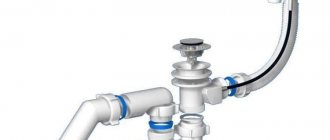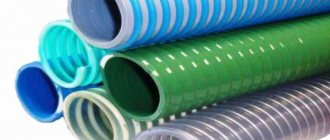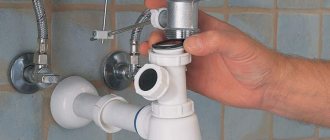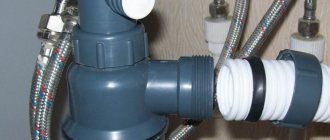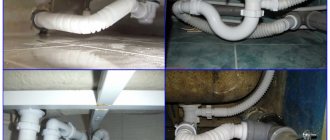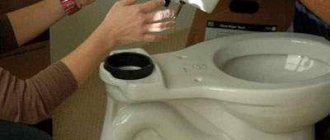- Structure and principle of operation of devices
- What materials are the devices made from?
- Available plastic products
- Durable metal devices
- Types of plumbing products
- Simple corrugated designs
- Convenient bottle-type devices
- Reliable pipe devices
- DIY Installation Instructions
- Dismantling the old device
- Features of assembly and installation
- How to care for your siphon
A siphon for a bathroom sink is a device that is necessary to allow waste water to pass through. This prevents troubles associated with clogged water pipes and helps avoid the appearance of sewer odor in the room.
Some siphons may include a water overflow outlet (left) in the sink.
Structure
A siphon is a metal or plastic structure that includes a reservoir and several pipes. One connects to the sink drain, the other to the sewer. It is in them that water flows when we wash our faces or wash dishes. Initially, the liquid from the sink enters the siphon, and from it through a curved pipe into the common sewer riser. A metal mesh located at the base of the device, on the sink opening, acts as a fine-mesh filter, protecting the system from blockages.
The curvature of the siphon ensures that a certain volume of liquid is retained, forming a water seal that prevents sewer odors from entering the house.
The purchased siphon kit usually includes a body, inlet and outlet pipes, metal mesh, linings and other consumables. Experts recommend purchasing models equipped with an overflow, which helps avoid flooding.
What to look for when choosing?
To make the correct choice of siphon, it is necessary to take into account the design of the washbasin, the assembly features of the mechanism and the location of the sewerage system.
If you are replacing not only the drainage device, but also the washbasin, it is advisable to choose sink models that already include a siphon. In this case, the organization of the drainage system will be simplified as much as possible, and all parts will be perfectly adjusted to the size of the washbasin.
The presence of an overflow and outlet unit for a washing machine in the design is solely optional. However, it is worth considering that only a bottle-type siphon can be additionally equipped with these elements.
The pipes for water sealing systems come in two diameters: 32 and 40 mm. It is worth remembering that the smaller the cross-sectional size, the lower the volume of liquid passed through the system, and accordingly, the siphon will often succumb to blockages
A low entrance to the sewer requires the installation of any type of siphon, except pipe siphons. To install it, you will need to raise the drain to the required level, which represents additional time and money.
When purchasing, you should also pay attention to the components - the parts must be intact and without chips. This is easy to do, because most manufacturers of plumbing fixtures make the packaging transparent.
Pipe siphon
Pipe is a popular option for a ceramic bathroom sink. It is not worth installing it in the kitchen, since it is more difficult to clean than other devices. These models are compact in size and attractive in design. The water seal is formed due to the curvature of the pipe. The lower leg of the device is usually removable. It will have to be dismantled to clean it.
The disadvantages of such a siphon include the following points:
- A shallow water seal, due to which the liquid evaporates quite quickly, and if the sink is rarely used, an unpleasant odor may appear in the room.
- The rigid design requires careful sizing: the siphon outlet must be located so that it can be connected to the sewer; installation is only permissible on standard drainage pipes.
USEFUL INFORMATION: Bathroom design in white colors (24 photos)
Bottle
Bottle siphon is the most popular type. Its design evokes associations with a flask or bottle, hence the name. The exhaust pipe can be either rigid or flexible corrugated.
Advantages of bottle devices:
- The siphon design allows you to effortlessly dismantle its most clogged part.
- This model is easy to maintain.
- The bottle drain does not need to be replaced for a long period of time.
- There is always water in the water seal, so the apartment is reliably protected from sewer smell.
- If small things get into the drain, they can be easily removed by unscrewing the flask.
The bottle version has some disadvantages: it accumulates contaminants in the drain container (hair, threads, grease), and is also more prone to leakage than other varieties due to the larger number of connections.
DIY Installation Instructions
Regardless of whether you have a wall-hung washbasin or any other type of sink, you can install the structure yourself. The main thing is to follow the basic rules.
Dismantling the old device
First you will have to dismantle the old siphon. Since there is always water left in it, you need to place a container so that the waste liquid pours into it.
It is important to carefully unscrew the screw from the drain grate. Sometimes this is difficult to do due to contamination, so chemicals have to be used to make the job easier.
Afterwards you can disconnect the pipe. All work of this type is carried out wearing protective gloves and a respirator.
Before disassembling the old siphon, carefully study its design.
Features of assembly and installation
In order to install the device, you must first read the instructions and check the package contents of the product. You will need to prepare a set of tools, the technician must have a screwdriver and a knife, and you will also need silicone sealant.
Installation algorithm:
- A metal protective grille is installed in the sink drain. A rubber flat seal is applied to it. If the hole depth is small, you can use a small amount of sealant instead of a gasket.
- A thick rubber cuff is placed on the upper side of the pipe, but only if it was not glued in at the production stage (you need to check it).
- A long screw is inserted into the mesh hole and fixed so that it is impossible to rotate the flange with the gasket installed.
- Regardless of the type of siphon, a tube, flask or corrugation is connected to the pipe. A union nut is placed on the free end of the product with the thread down. The wide edge of the cone seal should be installed towards it, 2.5-3 cm from the edge.
- Everything is inserted into the socket, the nut is tightened by hand.
- The cone gasket is fixed on the outlet pipe, then connected to the siphon drain. If the diameter of the pipes does not match, adapters are used.
Then they check the functioning of the system, for which they turn on the water, gradually opening the tap to the maximum.
Corrugated
This device is easy to install and consists of an outlet and a curved corrugated pipe.
Advantages of using a siphon for a corrugated sink:
- Can be connected to sinks and sewer risers even if their location is non-standard.
- Easy to install and affordable.
- The bend for the water seal is formed by the installer himself.
- Due to the absence of connections, the possibility of leakage is virtually eliminated.
- Regardless of the distance separating the sink and the floor, high-quality drainage will be ensured.
Like bottle drains, corrugated drains have their drawbacks:
- due to the unevenness of the inner surface, deposits of debris and dirt quickly form on it;
- hot water negatively affects the strength of corrugated pipes.
Practical recommendations
Before you go shopping for a siphon, it's a good idea to take some measurements. Firstly, measure the diameter of the drain hole, secondly, the distance from the sink to the sewer pipe and, thirdly, the diameter of the sewer hole.
It is best when it is possible to check directly with the seller whether all standard parts are available. Accordingly, in case of shortage, you can ask to replace one set with another. If you do not do this in advance, then if the product is of poor quality, problems may arise with its return. Then in this case you should worry about the safety of the check, if one is issued, of course. And this is another reason to buy a siphon not from hand at the market, but from a specialized plumbing store.
Regardless of the chosen type of siphon, be it corrugated, tubular or bottle, the installation principle is the same everywhere. The only main thing to consider is whether it is necessary to additionally connect any equipment. And if, in the case of a completed assembly, a leak is observed, then there may be several options:
- or the installation was performed poorly;
- or no gasket is installed;
- or the product itself is of poor quality.
Many factors can influence the quality of operation, so they must be taken into account immediately so as not to be disappointed in the product.
Flat siphon
A type of bottle device. The main difference is the compact size and flat flask. It is used in cases where there is simply no space for a standard product, for example when installing a sink above a washing machine.
Advantages of a flat siphon:
- Due to its compactness, it can be installed in the most difficult to reach places.
- Cleans up just as easily as a regular bottle model.
- Allows rational use of the space under the washbasin, for example for installing a household appliance or cabinet.
USEFUL INFORMATION: Bathtub design with shower: small bathtub with shower corner and separate stall
Assembling a structure with an overflow
Initially, the bottle is assembled. A suitable seal fits onto the thread of the flask, which is built into the bottom of the washbasin. Next, the bottom cover is screwed tightly. The connection must be tightened manually to ensure a tight connection.
Now you need to take the upper pipe, which is responsible for the drain in the washbasin, put a nut on it, and then put on the cone gasket.
In this case, the seal should be pulled with the wide side onto the pipe. After this, the element is inserted into the upper part of the siphon. The next step is to tighten the nut.
If an extension of the outlet drain connector is required, a rigid pipe is connected to it. In cases where the design does not require this, a corrugated pipe is installed immediately
A corrugated tube is connected to the overflow hole of the sink, and its other end is connected to the connecting pipe. This is very easy to do - the blade-shaped part is equipped with conical grooves that easily fit into the corrugation of the corrugation.
The installation of all pipes of the drainage unit - the bottom one, which drains water into the sewer, the middle one for draining the washing machine and the top one for overflow - is carried out in the same way as a vertical pipe.
Additional functional elements
Siphons installed under the sink may have the following accessories:
- Drain-overflow. If the washbasin is equipped with a second top drain, a siphon equipped with an additional pipe (overflow) is installed under it. This will avoid accidental flooding.
- Bottom valve. A mechanism installed in the drain hole instead of a grate and acting as a plug.
- Additional side fitting for connecting household appliances (washing machine or dishwasher).
- Duplicate branch. It has a special siphon designed for sinks with two bowls. We select a drain for them with the required number of outlets. This is exactly the device shown in the photo below.
General device
All types of siphons are filters for general sewerage. On the one hand, they retain household solid particles, on the other hand, they serve as a barrier to the penetration of sewer fumes into the apartment.
Siphon operating principle:
- Domestic waste flows through the upper pipe;
- solid waste settles in a glass/elbow/pipe with water, blocking the flow of gas from the sewer system;
- Through the second pipe, dirty water is drained into the sewer.
Structurally, siphons may vary depending on their purpose (sink, bathtub, dishwasher/washing machine), additional functions, and location. For example, a washing machine requires a device with a non-return valve, and a flat one with an overflow for a bathtub.
Possible materials of manufacture
Materials used to create siphons:
- Metal. The products are distinguished by their decorative appeal and increased strength, but over time they can be subject to corrosion and oxidation. They are usually made of brass, less often - of bronze, copper, stainless steel. The most common models are chrome plated. The main disadvantage is the difficulty in selecting the size, because shortening a metal pipe will not be easy.
Chrome-plated products are chosen for wall-hung and countertop sinks. Being visible, they not only do not spoil the design of the washbasin, but also complement it favorably.
- Plastic. Due to their affordable price and good performance, plastic products are in great demand and popularity. They are lightweight, simple in design, and resistant to household chemicals. In the connecting nodes, the plastic siphon is equipped with rubber seals, which increases the service life of the product and its tightness. The product range of many manufacturers includes models with a special antibacterial coating of the internal cavity, which prevents the settling of grease and dirt and reduces the rate of clogging.
Material basis
At the moment, manufacturers are ready to offer customers two types of structures, based on the materials used in their manufacture:
- metal;
- plastic.
Made from metal
Naturally, their price can be several times higher than polymer options, but their service life is much longer. As a rule, designers choose brass or bronze alloys for production. The metal siphon is not susceptible to corrosion processes, but can oxidize. To avoid such problems, they are plated. Of course, you can find stainless steel products on the market, but they are in less demand due to their high cost.
All connections between parts, threads or crimps, must be sealed with gaskets made of rubber or a combination of rubber and polymer.
Plastic
In this group, the cheapest are polyethylene products. They have a tubular structure, with a small number of connections. However, devices made of polypropylene are more in demand. The structure of the main parts is more rigid, which allows you to reliably connect all the parts together, as well as maintain their primary shape. Polymer products characterized by a complex design are made only from plastic. In cases where contact with high temperatures is expected, it is still better to give preference to polypropylene, it is less susceptible to this kind of influence and does not expand.

